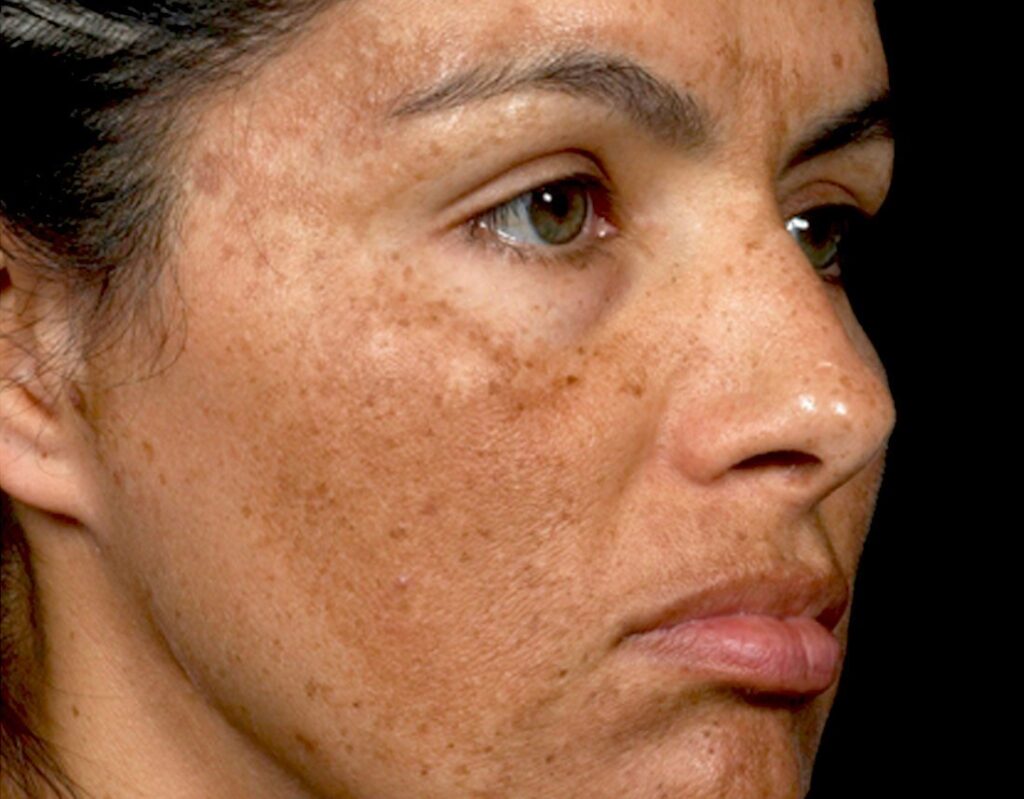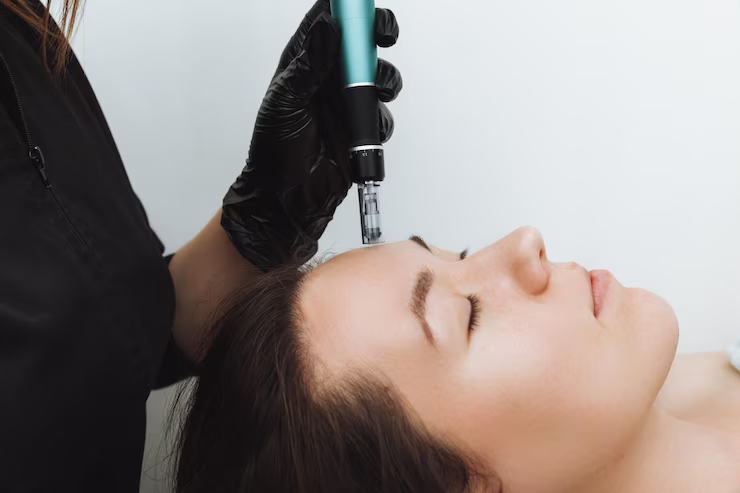Last updated on July 15th, 2025 at 05:03 pm
Melasma treatment refers to a set of medical or cosmetic procedures aimed at managing and reducing the appearance of melasma, a common skin condition characterized by the development of brown or greyish patches, usually on the face.
The melasma treatment can include topical creams containing ingredients like hydroquinone, chemical peels, laser therapy, microneedling, and sun protection measures.
Characterized by the development of brown or greyish patches on the face, melasma can be a source of self-consciousness and frustration. Melasma is a chronic skin condition that primarily affects the face, although it can occasionally appear on other sun-exposed areas of the body.
It is characterized by the development of hyperpigmented patches, typically brown or greyish in colour, on the cheeks, forehead, nose, and upper lip. These patches can vary in size and shape, and they often have a symmetric pattern on both sides of the face.
Melasma Symptoms
While the exact cause of melasma remains elusive, several factors are believed to contribute to its development. Hormonal changes, such as those experienced during pregnancy or while taking birth control pills, are known to trigger melasma in some individuals.
Additionally, excessive sun exposure is a significant factor, as ultraviolet (UV) rays can stimulate the production of melanin, the pigment responsible for skin colour. Genetics may also play a role, as melasma often runs in families.

Melasma Treatment
Melasma treatment, whether on the face or other areas of the body, shares common principles but may vary in approach due to differences in skin sensitivity and exposure. While the ultimate goal is to reduce hyperpigmentation caused by excess melanin production, treatment for melasma on the face often demands greater caution and precision.
This is because facial skin is more delicate and prone to sun exposure, requiring a diligent focus on sun protection and specialized treatments like laser therapy and chemical peels to ensure the best results.
In contrast, treating melasma on other body parts may involve less intensive methods. The good news is that there are various melasma treatment options available, and the choice of treatment depends on the severity of the condition, its underlying causes, and individual preferences.
Read: What are Generic Medicines?
Best Treatment for Melasma on Face
Some of the best treatments for melasma on the face are discussed below:
- Melasma Treatment Cream:
One of the most common and accessible melasma treatment options is the use of melasma treatment cream. These prescription creams typically contain active ingredients like hydroquinone, tretinoin, corticosteroids, or a combination of these.
Hydroquinone: This skin-lightening agent works by inhibiting melanin production, the pigment responsible for dark spots. It is often considered the gold standard in melasma treatment.
Tyromax Cream is one such cream that contains Hydroquinone. Order now from Medkart!
Tretinoin: Tretinoin, a derivative of vitamin A, helps improve skin texture and can be used alongside hydroquinone to enhance its effectiveness.
Corticosteroids: These ingredients can help reduce inflammation and irritation associated with other melasma treatments.

- Chemical Peels:
Chemical peels involve applying a chemical solution to the skin’s surface, which causes the top layers of skin to peel off. This process can effectively remove hyperpigmented skin and reveal a fresher, more even-toned complexion. Various types of chemical peels, such as glycolic acid or trichloroacetic acid (TCA) peels, can be used to target melasma.
- Laser Therapy:
Laser treatments, such as intense pulsed light (IPL) and fractional laser, have become increasingly popular for melasma treatment. These devices emit specific wavelengths of light that target and break down melanin in the skin. Laser therapy can lead to significant improvements in melasma, but multiple sessions may be necessary for optimal results.
- Microneedling:
Microneedling, which is a minimally invasive procedure, involves the use of tiny needles to create micro-injuries in the skin. This stimulates collagen production and helps improve the appearance of melasma over time. It is often combined with topical serums or platelet-rich plasma (PRP) to enhance results.

- Sun Protection:
Prevention is a crucial aspect of melasma management. Wearing a broad-spectrum sunscreen with a high SPF is essential to protect the skin from further UV damage, which can exacerbate melasma. Sunscreen should be applied daily, even on cloudy days, and reapplied every two hours when outdoors.
- Topical Antioxidants:
Incorporating topical antioxidants like vitamin C into your skincare routine can help protect the skin from UV damage and improve overall skin health. While not a standalone treatment for melasma, antioxidants can complement other therapies.
> Consult a doctor and Order Medicine Online
Conclusion:
Melasma treatment is a multi-faceted journey that requires patience and dedication. While there may not be a one-size-fits-all solution, individuals with melasma have a range of treatment options at their disposal. Consulting with a dermatologist is the first step toward finding the most suitable treatment plan based on one’s unique circumstances. With the right approach and consistent care, melasma can be managed effectively, allowing individuals to regain confidence and enjoy healthier, more radiant skin.
What is Generic Medicine?
A generic medicine is a medication that contains the same active ingredients as a brand-name drug and is equivalent in terms of safety, quality, dosage and intended use. The main difference is that generic drugs are typically less expensive because they are not marketed under a brand name and are usually available once the patent for the brand-name drug has expired.
Generic medicines must meet strict regulatory standards to ensure they are as effective and safe as their brand-name counterparts, making them a cost-effective alternative for many patients.
FAQs on Melasma Treatment
Q1: What is melasma treatment?
Melasma treatment involves various approaches to reduce the appearance of brown or greyish patches on the skin, typically on the face. These methods can include topical creams, chemical peels, laser therapy, and strict sun protection measures.
Q:2 Is melasma treatment permanent, or will the pigmentation return?
Melasma treatment can effectively lighten pigmentation, but it may return if sun exposure is not adequately managed. Sunscreen and protective measures are crucial for long-lasting results.
Q3: Are there over-the-counter creams for melasma treatment?
While there are OTC skincare products claiming to treat melasma, prescription creams with ingredients like hydroquinone are generally more effective and should be recommended by a dermatologist.
Q4: Can melasma be completely cured?
Melasma can be managed and lightened, but it’s often chronic. Long-term maintenance, including sun protection and occasional touch-up treatments, may be necessary to prevent recurrence.
Related Links: